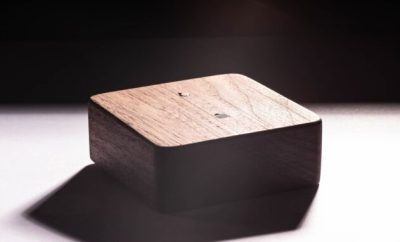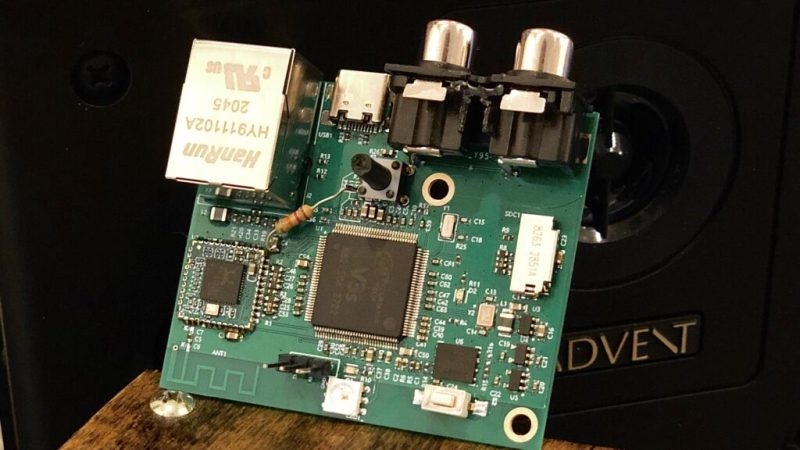If you want to hook up an existing stereo or amplifier to Spotify, there’s a fair few options on the market. You can even just order a Raspberry Pi and be done with it. [Evan Hailey] went his own way, however, and built his own Spotify Box from scratch.

The project is based on the Allwinner V3S, a system-on-chip with a 1.2GHz ARM-Cortex-A7 core, 64MB of DDR2 RAM, and an Ethernet transceiver for good measure. There’s also a high-quality audio codec built in, making it perfect for this application. It’s thrown onto a four-layer PCB of [Evan’s] own design, and paired with a Wi-Fi and BlueTooth transceiver, RJ-45 and RCA jacks, a push-button and some LEDs. There’s also an SD card for storage.
With a custom Linux install brewed up using Buildroot, [Evan] was able to get a barebones system running Spotifyd while communicating with the network. With that done, it was as simple as hooking up the Spotify Box to an amp and grooving out to some tunes.
Along the way, [Evan] learned all about compiling drivers and working with embedded Linux, as well as how to take a bare SoC and build it into a fully-functional single-board computer. When someone else says they “made” a Spotify player, he presumably gets to clear his throat.
If you fancy retro computers, consider interfacing Spotify with your classic Mac instead!
[Thanks to Jay Carlson for the tip!]

















I used the infamous pocket C.H.I.P. for this purpose, I installed mopidy and it was able to play not only Spotify but anything in the internal memory and web radio, all controlled by an mpd android app or mopidy-iris, a web interface.
what about playing youtube with youtube-dl?
Using these to “upgrade” old Philco style radios with modern amp/speakers could be a cottage industry…🤔
Noooooooooo!
Well, some radios are already gutted…
Oh, and these small boards could easily fit in a lot of old radios with the chassis intact, to allow some masochist the possibility of repairing it…someday.
All the tight pitch SMD devices and one giant honking through-hole bodge resistor across the top *chefs kiss*
“giant”? 🤨 That’s a tiny 1/4w resistor, not a 2w or 5w model!
Most likely last minute cpu reset button; a resistor is needed for pullup/pulldown.
i can’t believe spotify tolerates the existence of spotifyd! if they had not already so thoroughly burned their bridges with me, that might almost be enough to get me to try them again
Well they say “Spotifyd will not work without Spotify Premium”
Cool but the footprint looks about the same as an Apple TV which for about 100 buck can give you a lot more capabilities. I do see the fun in doing it though.
It gives you knowing,
When you buy an Apple Inc made product if you ask them you aren’t buying the product you are renting under an agreement the software. Why are you even in hear if you are going to say something so ignorant? If you wanna buy sure, but please don’t pretend you own that Apple crap you bought into. I sold all my iOS/MacOS hardware off years ago because of how anticonsumer they are.
This guy BUILT a Spotify Single board computer. He owns it. You buy an iWatch and you get to use it as long as you use it how the real owners Apple sees fit. Or they destroy it. You are talking about the company that would disable the LCD in the watch if you replace it because they detect unauthorized repairs.
Meanwhile we want real ownership. Please don’t compare your rental car to this guys custom built muscle car. It’s not funny it’s highly irritating.
It gives your ownership* I ought to have proof read. Oh well. I get riled up when people compare apples and oranges.
What does all that mean when it’s very easy to install Linux on a Mac? Apple makes the best Linux laptops.
I never heard of apple disabling the screen on the watch if you replace it.
They do however disable features like true tone when you replace the screen with something else though.
Batteries also dont give out the health status if you replace it.
I’m sorry, this is Hack-a-Day. You seem to be looking for Buy-a-Day.
Why are the commentors on this site such deadbeats? This is an awesome project for an EE undergrad. Armchair engineers please refrain from posting, particularly you Mr. Steven Naslund and pelrun. No fun committee.
Absolutely! The kid did an awesome piece of work and deserves appreciation for pulling off a fairly complex project at an undergrad level
There are definitely some similarities to the OtterCast (article https://hackaday.com/2021/04/06/you-otter-be-able-to-stream-that-audio-open-hardware-eclipses-chromecast-audio/).
I can’t help but feel some functional blocks are starting to become canonical. Nice build with its own spin, like it.
Oh, that’s the “otter’ one!
(grinning, ducking, and running!)
I wonder if my Chumby is up to the task. It also has only 64MB RAM, but it’s a significantly slower with its 350 MHz i.MX21 (ARM9)
Haha, for years I’ve been trying to remember what that thing was called! Thanks for fixing that itch. Almost bought one way back when but could never think of a use for it.
Just started to look into buildroot and SOCs and now I see them everywhere, Digi key also just released a Video about it on YouTube. Awesome timing. Can’t wait until my lichee pi nano arrives.
Does anybody know if this (Spotifyd) runs better than the actual Spotify Connect built in to many receivers? Mine has it built in and it’s garbage (keeps crashing out and locking up, if it’s ever discoverable in the first place).
I have an OrangePi zero that plays Spotify directly digitally to my Pioneer Receiver (that lost its native support some years ago because of Spotify protocol change) using DLNA. Can use any DLNA enabled device though.
For many months, I have been using a RPi 4 with a HiFiBerry on top running Spotify premium. I “split” the output to 3 different Class “D” amps so I can drive my main stereo (200WPC, my house in-ceiling speakers (25WPC) and my outdoor speakers (25WPC). All have separate volume controls, and any phone or computer can choose which playlist.
I remember using both an HP Jornada 720 and Sharp Zaurus SL-5500 as MP3 players. These both had 200 MHz StrongArm processors and could just about manage MP3 playback, so I suspect the Chumby would be powerful enough.
Before rpi became a thing I played online radio streams with custom router firmware. Stations were switched with ez setup button, and sound was played from USB sound card.
Anybody has checked the Cspot on github? Works on esp32
If he did this all from scratch in his own…. my mind is blown.
Doing the circuit design for all those components, even if he’s copying the application notes must have taken a while. Soldering those 0201 components must have taken ages too. And how did he know how to manage the circuit design for the high speed parts like Ethernet?
The article is missing both the project duration and attribution to people that helped him (IMO).